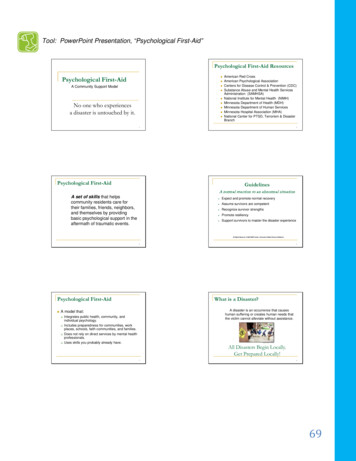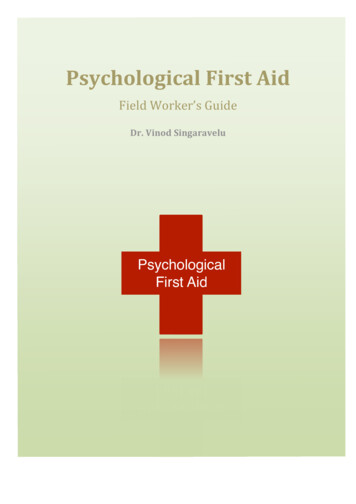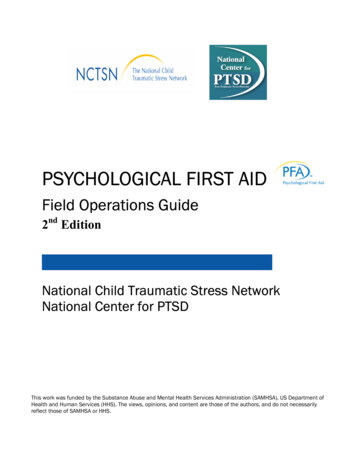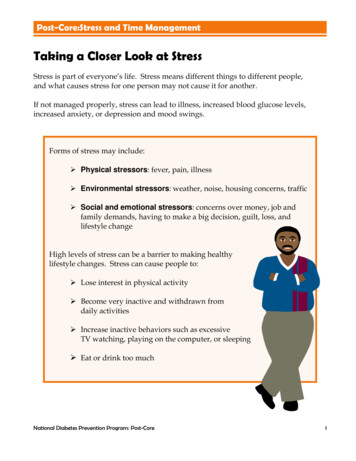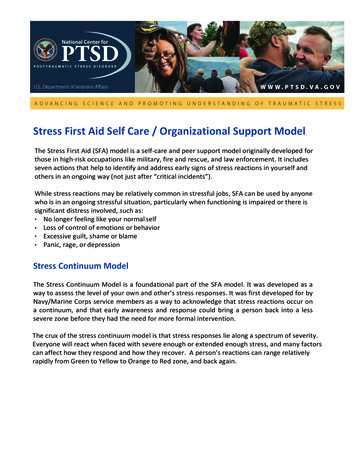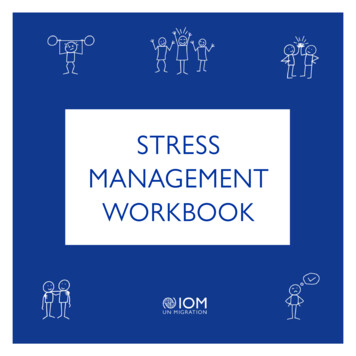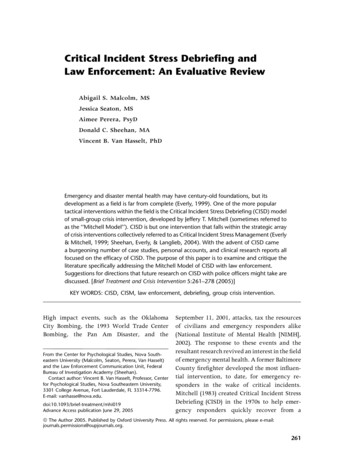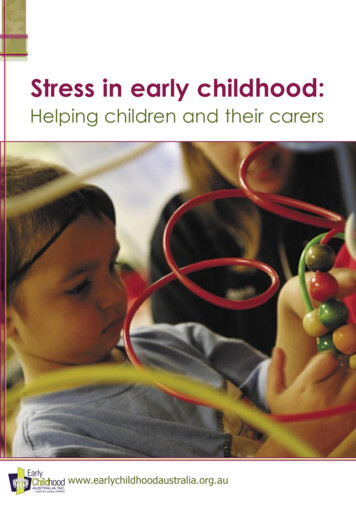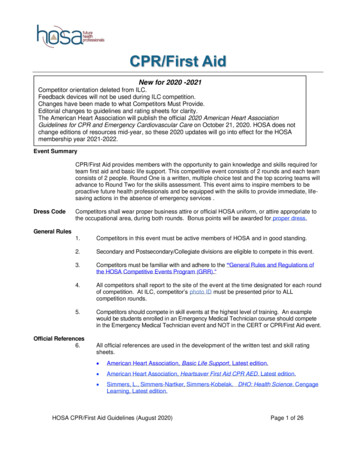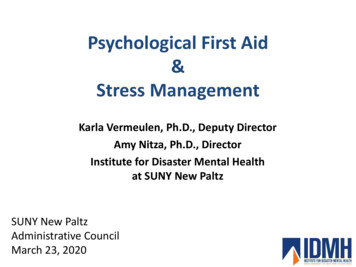
Transcription
Psychological First Aid&Stress ManagementKarla Vermeulen, Ph.D., Deputy DirectorAmy Nitza, Ph.D., DirectorInstitute for Disaster Mental Healthat SUNY New PaltzSUNY New PaltzAdministrative CouncilMarch 23, 2020
Agenda1. Understanding Stress– Stress vs. Trauma– Typical Stress Reactions– Outbreak-Specific Stressors2. Addressing Stress Among Students, Colleagues, andSupervisees through Psychological First Aid3. Handling Your Own Stress: Self-Care Beyond Lip Service– Occupational Hazards and Rewards– Stress Inoculation
Understanding Stress
Stress, Crisis, & TraumaStressCrisisfdffffffTraumaTrauma
Stress Definition: The physiological response to any demand forchange Types: Acute Stress: The response to a single experience that createsheightened demands for a limited period of time Chronic Stress: The cost of daily living: bills, kids, jobs stress wetend to ignore or suppress Traumatic Stress: The reaction to situations that are shockingand emotionally overwhelming, often involving actual orthreatened death, serious injury, or betrayal
Stress – it’s not all bad!Eustress:Stress in daily life thathas positive elements:being challenged atwork, birth of a child,pushing oneselfphysically, etc.
Trauma Definition The response to “an event, series of events, or set ofcircumstances experienced by an individual as physicallyor emotionally harmful or life-threatening, with lastingadverse effects on the individual’s functioning andmental, physical, social, emotional, or spiritual wellbeing.”(SAMHSA) Derived from Greek word for “wound”
Trauma TypesAcute: A single experience that activates the fight or flightresponse, such as: Disaster Being victim of a crime Motor vehicle accidentChronic: Ongoing threats to physical and emotional wellbeing, such as: Experiencing repeated intimate partner violence or childabuse Consequences of forced migration Incarceration
Stress & Trauma Reactions are understandable reactions to abnormal circumstances. are not necessarily a sign of pathology. can be immediate or delayed; the connection to the traumaticevent may or may not be obvious. change over time. For most people, distress will lessen andtheir usual ways of coping will return. can include symptoms in multiple realms.
Typical Reactions to Stress Exposure Physical: Jumpiness, breathlessness, digestive problems,fatigue, sleep disruption, headaches Emotional: Anxiety, depression, irritability, anger,vulnerability, tearfulness Behavioral: Social withdrawal, avoidance, neediness, selfmedicating with alcohol or drugs, altered sex drive Cognitive: Rumination, preoccupation, forgetfulness,difficulty concentrating Spiritual: Hopelessness, loss of faith, questioningbenevolence
Other Typical Reactions to Stress Shame: Damage to one’s sense of personal quality, sense that the self isdefective Guilt: Sense one may have harmed someone or violated an important code– Guilt due to absence: I should have been there to help– Survivor guilt: Why did I live when others didn’t?– Performance guilt: I could have done more to help othersPeople experiencing these reactions often have distortedperceptions, overestimating what they could have accomplished orunderestimating how much theyactually did.
Reactions Over Time – for typical disastersSource: Fundamentals of Disaster Mental Health Practice,NYS Office of Mental Health
Outbreak-Specific Stressors:General Uncertainty & Unfamiliarity Threat is invisible, with unclear timing of effects(both personal and societal) Impact is unpredictable (obviously serious, but notclear how serious it will get) Unprecedented use of social distancing is creatingboth practical and emotional stress Rapidly changing and sometimes conflictinginformation from authorities adds confusion
Outbreak-Specific Stressors:General Uncertainty & UnfamiliarityResult: Constant need to adapt, withratcheting up of our baseline stress levelscaused by activation of each new level ofresponse measures!
Outbreak-Specific Stressors:Medical Fears Will I get sick?– If so, how bad will it be?– What if I’m infected but asymptomatic and inadvertentlyinfect other people? Will my loved ones get sick?– If so, how bad will it be?– Are they in high-risk groups?
Outbreak-Specific Stressors:Caregiving Concerns If I get sick:– How will I continue to care for my dependents?– Who will take care of me? If my loved ones get sick:– How can I care for them while trying to work and meetother obligations?– Will they have access to needed medical care if they getseriously ill?
Outbreak-Specific Stressors:Practical Concerns Will we have access to needed supplies or will thesupply chain start to fail? Can we access healthcare resources for non-COVID19 medical needs? How will this impact my children’s education? Will I continue to be paid or do I risk loss of income,or entire job? Other, due to individual circumstances anddemands
Outbreak-Specific Stressors:Social Concerns How will this impact my broader community? Will this bring us all together or sow further partisandivisiveness? Will other people hoard necessities, fueling a senseof competition for scarce resources? How can we stay connected to each other undersocial distancing rules? How will we make up for missed experiences, likekids’ birthday parties or graduating seniors’commencement ceremonies?
Outbreak-Specific Stressors:Work-Life Balance Concerns How can I manage to work effectively from home foran indefinite time while keeping my kids educated /busy / sane? How can I set boundaries between work andpersonal life when there’s no physical dividebetween realms?
Outbreak-Specific Stressors:Work-Life Balance Concerns For supervisors: How can I foster a cohesive workenvironment, effectively manage my team remotely,and support their well-being while maintainingproductivity? For professors and staff who deal directly withstudents: How can I try to meet all of their needs,pedagocically and emotionally, without becomingoverwhelmed?
Addressing Stress Among Students,Colleagues, and Supervisees
Evidence-Based Principles ofEarly InterventionIntervention and prevention efforts shouldinclude:– Promoting sense of safety– Promoting calm– Promoting sense of efficacy in self and community– Promoting connectedness– Instilling hope(Hobfoll et al., 2007)
Psychological First Aid
Psychological First Aid: Characteristics Universal – can be provided to all survivors Short-term; here and now Focus on interrelated practical, physical, andemotional needs Promotion of recovery to pre-event functioninglevel, not opening up past wounds for examination
Psychological First Aid: Characteristics PFA is not a process, but a toolkit of components to beused as needed, in any order appropriate Depending on your role and timing in a response you maybe more or less likely to use certain elements Can be used to support colleagues, as well as clients Goal is to remove any barriers to survivors’ naturalrecovery processes and to provide basic, immediatesupportive care
Psychological First Aid: ElementsProviding comfort careRecognizing basic needs and helping to solve problemsValidating survivors’ feelings and thoughtsConnecting people with their support systemsProviding accurate and timely informationProviding education about stress reactionsReinforcing strengths and positive coping strategies
Recognizing Basic Needsand Helping To Solve Problems Crises often create a variety of physical needs and logisticaldemands that can feel overwhelming to survivors You may be able to help people whose judgment anddecision-making ability is temporarily impaired Break down the brick wall!
Validating Survivors’ Feelings and Thoughts Living through a traumatic event is a new and confusingexperience for most people You may be able to help them identify or express theirfeelings – but don’t push someone to talk about theirexperience if they’re not ready to! The fact that others suffered worse losses doesn’t minimizethe impact of that individual’s own losses
Expressing Empathy Empathy vs. sympathy These phrases express empathy and help you make sure youunderstand what the survivor is trying to say:––––“I hear you saying ”“It sounds like ”“It seems to you ”“You appear ” If you get it wrong, apologize and ask the survivor to clarifytheir point
Expressing EmpathyThese phrases should be avoided: “Don’t feel bad.” “I know how you feel.” “Don’t cry.” “It’s God’s will.” “Try not to thinkabout it.” “It could be worse.” “Let’s talk aboutsomething else.” “At least [anything].” “At least you still have. ”They mean well, but feel dismissive or invalidating tothe survivor.
Connecting People with Support Systems Most survivors receive far more comfort from existing supportnetworks than from any professional intervention, so reconnectingwith loved ones is a key PFA goal – even if that must be donethrough technology Social support can be: Instrumental Emotional Informational Some may resist reaching out, not wanting to be a burden – ask“what would you want if the roles were reversed?” BUT – some friends and relatives would NOT provide positivesupport, so accept when resistance to reaching out is appropriate
Providing Accurateand Timely InformationAccurate information is an important antidote forthe uncertainty and anxiety survivors experienceafter a crisis!
Providing Accurateand Timely Information Stay aware of any up-to-date lists of available resources,treatment guidance, etc. Present information in simple language and provide it inwriting if possible Be sure never to give out unconfirmed news, or shareinformation you’re not authorized to Say “I don’t know” when necessary, but preferably “I don’tknow, but .”
Reinforcing Strengths andPositive Coping Strategies It’s important to acknowledge and support a survivor’sstrength, competence, courage, and power to begin torestore a sense of control You can ask: “How have you gotten through tough timesbefore?” or “What skills do you have that will allow you toget through this?” Survivors can be warned about ways of coping that makethem feel better temporarily but don’t really help in the longrun Encourage them to use effective methods that help themboth feel and function better
When Using PFA, Remember Goal is to help people return to baselinefunctioning, not fix all of their problems People should not be treated identically;individual needs and cultural differences must berespected You MUST understand limits of PFA, and knowwhen and how to refer for more intensive mentalhealth care if needed
PFA Do’s and Don’tsDON’TDOOver-promise or over-reassureBe realistic in your assurancesMinimize the survivor’s losses ormake comparisons to othersurvivorsValidate the survivor’s feelingsChange the subjectStay with the survivor’s focusFill up silence with chatterLearn to tolerate silenceTake survivor anger or frustrationpersonallyAccept that they’re venting andit’s not really aimed at you
PFA Video ExamplesVaccination clinic:- Anxious students in linehttps://www.youtube.com/watch?v Zu4-mrzgUls- Disgruntled colleaguehttps://www.youtube.com/watch?v F7tajXi-G10
Questions so far?
Handling Your Own Stress:Self-care Beyond Lip Service
The “Self-Care Imperative”Remember: People who don’t take care ofthemselves will not be able to take care of othersor meet their professional demands.Therefore, taking steps to manage your own stressand maintain your resilience is not a luxury or asign of weakness – it’s an ethical responsibility!
The Compassion Stress ContinuumCompassionSatisfactionCompassionFatigue
Compassion Satisfaction Positive aspects of helping Described as “the pleasure you derive from doingyour work” (www.proqol.org) Includes:– Sense of accomplishment– Sense of purpose– Sense of competence in being able to help others
Compassion Fatigue Caused by overextending one’s capacity for selflessness Refers to the deep emotional and physical “wearing”down that takes place when helping professionals areunable to refuel and renew (Figley, 1995) Experienced as a gradual erosion of all the things thatkeep us connected to others in our caregiver role:empathy, hope, and compassion – not only for others butalso for ourselves (Mathieu, 2012)
BurnoutChronic condition that develops gradually over time,marked by:– Emotional exhaustion– Reduced feelings of accomplishment or that your effortsmake no difference– Difficulty dealing with work and/or doing your jobeffectivelyAssociated with:– Very high workload– Non-supportive work environment
Common Barriers to Self-Care Lack of experience Lack of training Myth of professional immunity (“I take care of otherpeople, I don’t need any help myself”) Negative self-talk (“Everyone else seems to bemanaging – I must be weak for feeling this way”) Stigma (“They’ll think I can’t handle the job if I askfor help”)
Self-Care:Emotion- & Behavior-Based Strategies ise
Self-Care:Cognition-Based Strategies ‘Self-Talk’ Cognitive Restructuring Stress Inoculation
Stress Inoculation
Stress Inoculation Goal is to manage stress – not to get rid of it! Preparing in advance for the realities of an experiencewill help you: Acknowledge that the stress exists and will impact you Manage your expectations of the event and of yourself Predict the intensity of emotions and interpersonalinteractions you’re likely to experience Practice or mentally prepare
Stress InoculationComponents:1. Identify potential stressors2. Appraise stressors3. Identify personal coping strategies– Problem-focused– Emotion-focused4. Identify organizational coping strategies
Stress Inoculation:1. Identify Potential Stressors Trying to identify personal potential stressors allows forpreparation and realistic expectations for your response – akind of mental rehearsal, giving you a chance to predict whatmay happen and how you could most effectively respond. Think as specifically as possible about what you might findmost stressful:––––Sights, sounds, smellsExposure to other people’s distressFeeling unconfident / unequipped to deal with a new experienceUncertainty about the future
Stress Inoculation:2. Appraise Potential Stressors People experiencing stress make a subjectiveevaluation balancing the stressful situation withtheir perceived ability to meet the demands. Behavior depends on which appraisal is made: that the situation is a threat that the situation is a challenge
Stress Inoculation:2. Appraise Potential StressorsIf situation is appraised as a threat: Available coping mechanisms can become overwhelmed, and anxietyand stress can continue to build You may limit your coping skills to one or two that may be minimallyeffective in dealing with the stress You may become paralyzed in terms of thinking and be unable toorganize, prioritize, or develop a plan of action If you’re confronting a perceived challenge you’re likely tothink things like “This is awful!" or "I can't do this.“ This appraisal is likely to lead to an inability to cope orproblem-solve.
Stress Inoculation:2. Appraise Potential StressorsIf situation is appraised as a challenge: You’re more likely to mobilize the psychological resources at yourdisposal Coping skills used are likely to be varied and potentially new You’ll be more able to break the situation into manageable pieces You can create or follow a plan for helping others When you confront a perceived challenge you’re more likelyto think things like "I can handle this" or "Where do I start?“
Stress Inoculation:2. Appraise Potential Stressors The final level of appraisal is to assess whether perceivedstressors are: Under one’s control Not under one’s controlIn other words, can you actually change the source of thestress? If so, how will you do that? If not, how will you still cope with what can’t be changed oravoided?
Stress Inoculation:3. Identify Personal Coping StrategiesIf you appraise a situation and find that aspects can be changed orresolved, a problem-focused coping strategy can involve: Breaking problems into manageable parts Problem-solving Brainstorming Symptom management Skill development
Stress Inoculation:3. Identify Personal Coping StrategiesIf little or nothing can be changed about the event or the response,then emotion-focused strategies will be most helpful. Elementsinclude: Relaxation Distress tolerance Emotion regulation Anger management Distraction skills
Stress Inoculation:4. Identify Organizational StrategiesDepending on your role, you can also help combat stress bymaking changes within the structure of the organization toimpact how work and stress are perceived including: Ensuring that orientation and supervision of staff focuses onpreparing for expected stressors Providing realistic preparation to help staff be aware of what theymight be exposed to and give themselves time to think about howthey’ll respond to these conditions Dividing tasks into essential and non-essential, allowing staff toprioritize and minimize the risk of becoming overwhelmed
How are you viewing each stressor?As a threatHow can youreframe it as achallenge?: Positive selftalk Rememberyourstrengths Reach outfor supportStress InoculationFlowchartAs a challengeIs it somethingyou can controlor change?Yes:Try problem-focusedcoping strategies:No:Try emotion-focusedcoping strategies: Breaking problemsinto manageableparts Relaxation Problem-solving Brainstorming Skill development Distress tolerance Emotion regulation Anger management Distraction skills
Discussion / Questions?
1. Understanding Stress –Stress vs. Trauma –Typical Stress Reactions –Outbreak-Specific Stressors 2. Addressing Stress Among Students, Colleagues, and Supervisees through Psychological First Aid 3. Handling Your Own Stress: Self-Care Beyond Lip Service –Occupational
